Some of our Lobster Pots are missing
Posted: 12 April 2013 20:12
Since I was young I have been fascinated by the Luftwaffe's Rettungsbojen, which were floating refuges anchored in the English Channel for downed aircrew. The British nicknamed them Lobster Pots.
It wasn't until quite recently that I discovered that a handful of these refuges actually ended up on the coast of East Sussex and so I set about researching them.
History and description
The survivability of aircrew in the Channel depended largely upon whether or not they could be picked up by air-sea rescue services. Cold even in summer, exposure accounted for many aircrew left in the water.
The Luftwaffe therefore set out to provide a form of refuge in which aircrew could seek shelter, dry clothes and food while they awaited rescue. My interest in the Rettungsboje (Rescue Buoy) dates back to the 1980's, when I saw an illustration of one in a book about the Battle of Britain and in a couple of films.
The Rettungsbojen (also known as Udet-Bojen after the Luftwaffe's head of equipment, Generaloberst Ernst Udet) were anchored about ten miles off the coast of France. In late 1940, some started to find their way across the Channel and were washing up on the beaches of Kent and Sussex.
The Illustrated London News of 7th December 1940 published a short story and cutaway illustration of this new device. The whole article was subsequently translated and re-published in the German magazine Der Adler in February 1941! The British magazine The War Illustrated also ran an article in February 1941 - the 'lobster pot' had certainly caught the imagination of the press.
I set out to create a 3D model as seen in the graphic below. Broadly speaking, the buoy was a chamber 4m long, 2.5m wide and 2.5m high, with a 2m-high conning tower topped off with a 2.5m mast.
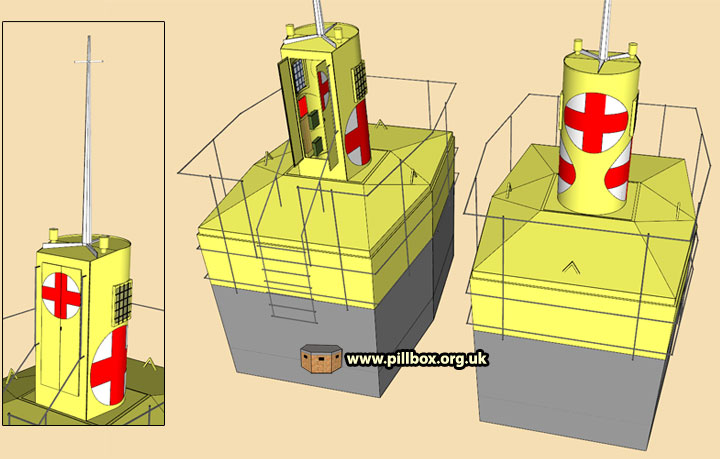
A pair of doors in the rear of the tower provided entry to the chamber via a hatch and ladder.
In the tower itself were stored signal flags and flares; a flag was to be run up the mast to signal to passing aircraft that the buoy was occupied.
In the main chamber were four bunk beds and cupboards full of all sorts of provisions, from food and water, to clothes, tools and games.
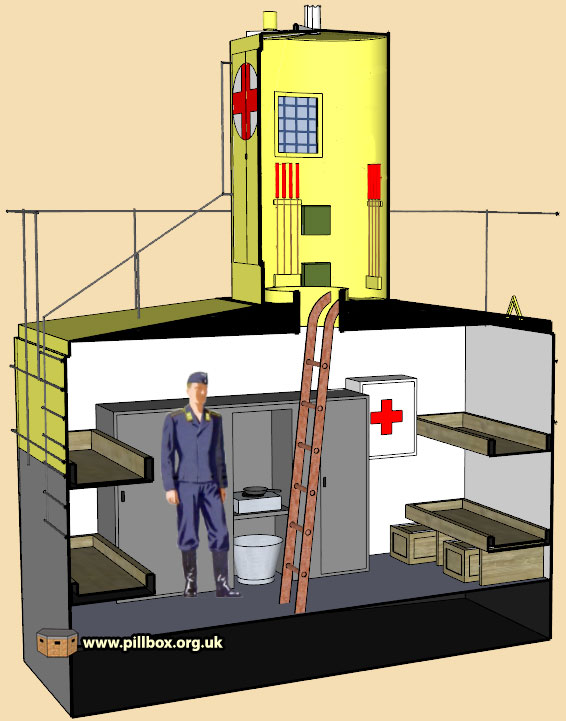
The 3D model
I only had basic dimensions to work from, so I don't claim the model to be precise in every detail; it's only meant to give an impression rather than be accurate down to every rivet.
Photographs proved to be the key to the exterior; a couple of good ones from the archives were used to get the proportions correct and the rough dimensions were used to scale the model.
The cutaway at right is based on various contemporary press reports and illustrations and is only a rough impression of how the interior might have looked.
Even the few sources I did find seem to illustrate different internal layouts, so this is purely speculative.
Some sources place the bunks along the side walls as opposed to the ends and it's entirely possible that variations existed.
In the end, I went for the layout as given in the The Illustrated London News article, as it matched that seen in one of the wartime films, mentioned below.
There is some debate as to whether any form of radio was carried; this is implied in some of the press reports, but an official document I found in the archives states that none of them had any wireless equipment. One of the press reports does, however, mention a wireless receiver (as opposed to a transmitter) and this distinction may hold the key to this particular anomaly.
The captured Rettungsbojen
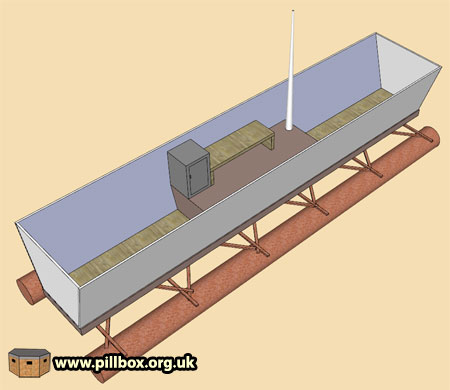
The earliest mention I could find in the documents relates to a 'barge' that was first seen on 6th November 1940, off the Kent coast at St. Margaret's Bay. The vessel subsequently washed ashore the next morning.
There is only a text description of the barge, but my speculative interpretation is seen at right.
The vessel was about 10m long and comprised a wooden platform mounted on a pair of metal cylindrical floats.
A central raised platform had a flagstaff, a bench and a waterproof safe bolted in place.
The safe was found to contain four pairs of trousers, four French greatcoats, blankets, first aid kit, 15 bottles of lemonade, two bottles of Burgundy, one bottle of brandy, eight packets of chocolate and four packs of biscuits.
A battery-powered Osram light bulb and red cross flag were supplied for signalling.
The initial fear, namely that German agents had landed, was quickly dispelled:
The barge was found at the foot of the cliffs which are about 250ft high, and it would be impossible for anyone to land at this spot. The inference is that no-one came ashore. It appears more likely that this craft is one of those which the Germans are apparently mooring in the Channel to aid any of their pilots who may be forced down before reaching the French coast.
This appears to have been the first encounter with the Rettungsbojen, albeit of a primitive - perhaps ad-hoc - variant, before the more familiar type began arriving on the English coast.
The first lobster pot?
The earliest press article I can find is the aforementioned Illustrated London News piece of 7th December, meaning that the first lobster pot must have been captured some time prior to this.
The archive files are surprisingly bare on the Rettungsbojen; I managed to locate only one that contained a few memoranda and two photographs and it was one of these that leads me to think that perhaps the first lobster pot landed near Cuckmere Haven, East Sussex.
I've searched the local military files for the area at this time, but there is no record. The war diary for the battalion holding the Cuckmere Haven defences during this period is missing.
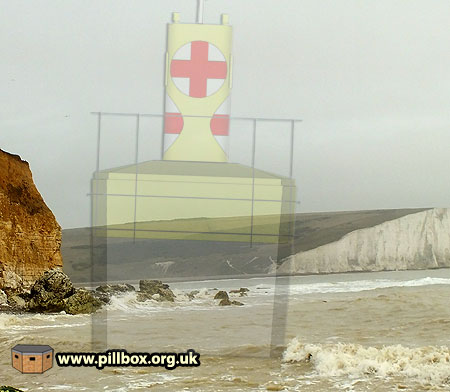
The only clue that a buoy landed here (actually at Hope Gap, just to the west) lay in one of the photographs that accompanied a memo dated 6th December 1940.
The location is not given - only reference made to the 'South coast'. The only reason I managed to identify the spot at which the photo was taken was by recognising the background - if I hadn't drawn this file, I would probably never have found this out!
I went out to the spot and took the photo at right and superimposed the ghostly lobster pot to recreate the original shot (which is copyrighted, hence my not using it).
The shape of the cliffs at left and the rolling Seven Sisters in the background are an almost perfect match between the 'then' and 'now' photos.
Of course, this photo doesn't prove in itself that this was the first lobster pot to be washed ashore, but a memo associated with the photos states that "this idea seems worth copying as a safety measure" and that the matter should be brought to the attention of a higher authority, which to me indicates that this was the first one encountered.
Neither was it the last; the file refers to another that was washed ashore at Sandgate, Folkestone on 22nd December and towed to Dover.
Then another harvest in East Sussex - the war diary for the infantry brigade in the Newhaven Sector in 1941 records some interesting encounters:
1st March 1941: Two enemy hospital floats seen out to sea, one was secured and brought into Newhaven Harbour. Naval authorities report that these floats when far out at sea strongly resemble the conning towers of submarines.
28th March 1941: 16:00 - Hospital float brought into Newhaven Harbour. On inspection it was found to contain every imaginable luxurious facility.
1st April 1941: 16:45 - German hospital float towed into Newhaven Harbour.
Rettungsbojen in films
I wasn't the first person to be intrigued by the lobster pots; they appear in two films of the period; We dive at dawn (1943) and One of our aircraft is missing (1942). (See what I did with the title of this post?) Coincidentally, actor Eric Portman appears in both films.
In We dive at dawn, a British submarine encounters a buoy containing some German airmen. The Commander, played by John Mills, orders that the mast be shot off by machine-gun fire before a radio message can be sent out. A quick interior shot is seen, but detail is not clear. This scene happens at about 34 minutes into the film.
One of our aircraft is missing does give some good footage of the interior (at about 1:31), and this was invaluable for my 3D model. An RAF crew is escaping by rowing boat and they end up in a buoy with two Luftwaffe aircrew. Again, there is a radio fitted, German E-boats are on the way, but the Royal Navy get there first and tow the buoy back. The entrance in the tower appears to be a single hatch as opposed to twin doors, but this might have been a film set mock-up.
Watching these films again, I wonder whether either of the lobster pots in them originally found themselves on the Sussex coast.
Equipment carried
The infantry brigade quoted above state that lobster pots contained "every imaginable luxurious facility"; I found the following list in the files:
| Shelf | Cupboard A | Cupboard B | Cupboard C |
|---|---|---|---|
| 1st | 1 Canister of petrol 2 Spirit stoves 1 set spirit blocks 2 packs of storm matches | EMPTY | 1 chemist's shop 4 packets of bandages 5 sea sick bags (paper) |
| 2nd | 6 sets of overalls 6 pairs canvas shoes 6 hand towels 4 scrubbing cloths | 1 box flares with flare pistol 1 set smoke cartridges 2 packs each of 10 red flares 1 pack of 10 white flares 10 slow-burning matches | 2 cooking vessels Cutlery etc 4 drinking mugs Small quantity of tea and sugar |
| 3rd | 1 lavatory bucket Toilet paper | EMPTY | 2 boxes of provisions in case of wreck 1 flask brandy 2 packets of cigarettes |
| 4th | (None) | 4 straps, 10m long 1 set of packing plugs and mallet for plugging bullet holes 2 emergency flags (hand) | 1 knife 1 roll of thread 1 compass 2 rolls insulating tape 1 set of entertaining games 2 packs of cards 1 writing set |
| 5th | (None) | (None) | 1 set of carpentry tools |
Attention to detail is shown by the inclusion of vomit bags, and also plugs to block up bullet holes. The latter indicate a stark realisation that the British took a dim view of the red cross symbol being used in connection with returning valuable aircrew to continue the aerial onslaught. The similarity to a U-boat conning tower (apparent in the graphic below) was also likely to attract attention.
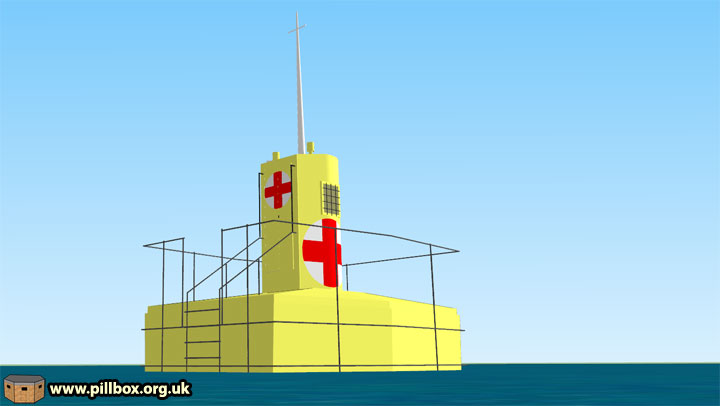
An interesting little episode to my research. Having been fascinated by the Rettungsbojen for more than 30 years, when I really began to research them only just last week, I hadn't realised that, far from being out in the middle of the English Channel where only aircrew and filmstars would encounter them, part of their story actually lay much closer to home!
- Pete

Email:
Blog Latest

Bishopstone reveals its pillbox secrets
18 October 2021

Pillbox or Observation Post?
10 June 2020

Uncovering the hidden secrets of a pillbox
8 June 2019

Review of 2018
31 December 2018

Wartime Christmas in East Sussex (2)
24 December 2018
Jargon-buster
War diary
A record of events kept by all units from the point of mobilisation. A diary's contents vary enormously from unit to unit; some give detailed entries by the hour on a daily basis while others merely summarise events on a weekly/monthly basis.
This site is copyright © Peter Hibbs 2006 - 2024. All rights reserved.
Hibbs, Peter Some of our Lobster Pots are missing (2024) Available at: http://www.pillbox.org.uk/blog/216723/ Accessed: 16 April 2024
The information on this website is intended solely to describe the ongoing research activity of The Defence of East Sussex Project; it is not comprehensive or properly presented. It is therefore NOT suitable as a basis for producing derivative works or surveys!